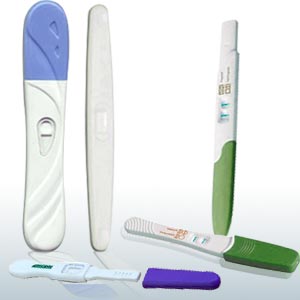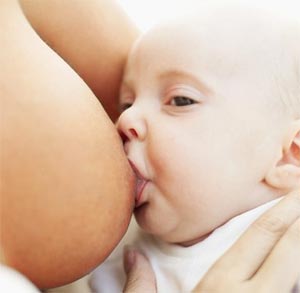Ovulation Test Strips

Ovulation tests can be of great help in determining your path to pregnancy. An ovulation test is a type of fertility test that detects the luteinizing hormone (LH) in a woman's urine. Ovulation tests or ovulation predictor kits (OPKs) are excellent tools for predicting ovulation, a women's most fertile time during her menstrual cycle.
Apart from just confirming that ovulation has taken place, ovulation test can also help you anticipate ovulation during your menstrual cycle, thus helping you determine the most fertile time of yours.
Ovulations tests
Ovulation occurs when an egg is released from the ovary and passes into fallopian tube.
Sperm must fertilize this egg within 24 hours after its release for pregnancy
to occur. There are different types of ovulation test to determine the most
fertile time of yours. Few of them include:
Ovulation predictor kits, Urine LH Ovulation tests: This test works by detecting the LH surge in a women's urine. A women's body generally produces large amount of luteinizing hormone (LH) immediately prior to ovulation. This generally happens during the middle of the menstrual cycle. During the menstrual cycle, only a small amount of LH is made, but in the middle of the cycle, LH dramatically increases. This increase is called LH surge.
Doctors opine that a positive result on an ovulation test means that the woman will most likely become fertile over the next three days - with peak fertility at 36 hours following the LH surge.
Fertility monitors: Fertility monitors are devices that help you determine your time for pregnancy. Many couples are buying fertility monitors today irrespective of its cost. Fertility monitors are costlier than ovulation predictor kits. Although the market has a variety of fertility monitors, most of them can be grouped under two categories - Saliva based and Urine based fertility monitors.
Ovulation Saliva tests :When a woman is about to ovulate, her saliva begins to form a distinct fern-like pattern which can be viewed under a microscope. These patterns are formed as a result of salinity which is caused due to the increased level of estrogen in the body. Salinity produces ferns that begin to appear around three days prior to ovulation.
Most women predict their fertile times by observing the visual changes that take place in their saliva using a personal ovulation microscope. The fern-like pattern formed in the saliva can be easily identified when examined under the power of a 40x to 60x magnification lens.
How to use ovulation strips
There are many ways to determine your ovulation period. Most women prefer the home
based ovulation test that are done with the help of ovulation strip or
fertility monitors. Home based ovulation strips, which are found to be highly
reliable, detect the LH surge by chemically analyzing a urine sample to detect
the amount of LH present.
Specimen collection: Fill a sterile container with urine. Collect urine once per day during your menstrual cycle between 10.00 AM and 8.00 PM. Remember, not to use first morning urine sample, since they are not effective in determining the LH surge.
You can store the urine if required. However, for best results, test the urine on the same day it is collected. Urine samples may be stored at room temperature (15º-28ºC) for up to eight hours, or in the refrigerator for up to twenty-four hours. Do not freeze the urine sample.
Best time to test: To do an ovulation test at home, you need to understand and be able to determine the length of your menstrual cycle. The length of the menstrual cycle is the number of days from the starting day of your last month period (LMP) to the day before bleeding begins on the next period. In other words, it is the number of days between your LMP cycles.
Before starting an ovulation test with ovulation strips, determine your usual length of the menstrual cycle for the last few months. Then, refer to the Ovulation Calendar Cycle Chart below to determine on which day of the menstrual cycle to begin testing. If your cycle is less than twenty-one days or greater than forty days, consult a physician.
| Your Cycle Length | Day to Begin Testing |
| 21 days | Day 5 |
| 22 days | Day 6 |
| 23 days | Day 7 |
| 24 days | Day 8 |
| 25 days | Day 9 |
| 26 days | Day 10 |
| 27 days | Day 11 |
| 28 days | Day 12 |
| 29 days | Day 13 |
| 30 days | Day 14 |
| 31 days | Day 15 |
| 32 days | Day 16 |
| 33 days | Day 17 |
| 34 days | Day 18 |
| 35 days | Day 19 |
| 36 days | Day 20 |
| 37 days | Day 21 |
| 38 days | Day 22 |
| 39 days | Day 23 |
Procedure to test
Remove the ovulation strip from the pouch. Carefully, dip the end of strip into the sterile urine container for 5 seconds. Then, lay the strip flat on a clean, dry, non-absorbent surface. Watch for the
urine levels in the strips. Do not allow the urine level to exceed the line
indicated as MAX line in the strip; else it might fetch inaccurate results.
Once collected, wait for colored bands to appear on the strip. This might happen in 40 seconds of urine collection.
Interpreting results
Within three to five minutes, two color bands will appear on the ovulation strips. Comparing the color intensity of these bands to the control band, helps you determine your ovulation period.
Result 1: A test band indicating your LH surge is usually equal to or darker in color than the control band. This is a positive indication that you are ovulating. Remember, light test band color does not indicate positive result, since there is always some amount of LH present in women's urine.
Result 2: The ovulation test result is considered negative when the color in the test band is lighter than the control band. This indicates that LH surge is not in progress and the hormone is still at base level.
Chances of invalid test result is very rare, however it happens when control band does not appear within five minutes. Doctors suggest that six to ten days of testing may be needed to detect the LH surge. Continue the test as prescribed by your doctor and determine at each test whether you are having LH surge. Ovulation is most likely to occur sometime in the day and a half following the first day of the LH surge.
Do not be disappointed if your test result is negative. Keep continuing your test as per doctor's advice to determine when the LH surge is happening within you.
Ovulation predictor strips
Remember few precautionary steps like reading the instructions page before using any ovulation tests. Do not take the test on your own; consult with your doctor before doing the same even at home. Because, few medications like menotropins, danazol or fertility drug clomid may skew the result.
Ovulation test is useful in determining your fertile period. When these tests are used along with other fertility predictors such as BBT, cervical mucus and cervical positioning, you will begin to see the pattern of your menstrual cycle. A better understanding of your menstrual cycles and other bodily intricacies will ultimately help you achieving pregnancy.
Top of the Page: Ovulation Test Strips
Tags:#ovulation test #ovulation test strips #saliva ovulation test #ovulation predictor test #home ovulation test
 Planning Pregnancy
Planning Pregnancy Pregnancy Diet and Exercise
Healthy Weight Gain in Pregnancy
Pregnancy Food Cravings
Pregnancy Heartburn
Improving Fertility after 35
Ovulation Test Strips
Pregnancy Symptoms
Early pregnancy cramping
Early pregnancy Test
High Risk Pregnancy
More on Pregnancy
 Natural Childbirth
Natural Childbirth Premature Birth
Pregnancy Massage
Pregnancy Problem
Pregnancy Due Date Calculator
Amniocentesis
Twin Pregnancy
Ectopic Pregnancy
Pregnancy Morning Sickness
Molar Pregnancy
Pregnancy Ultrasound
Constipation during pregnancy
Insomnia during Pregnancy
Smoking during Pregnancy
Teen Pregnancy
Exercise during pregnancy
Late Term Abortion
Sign of Miscarriage
Pregnancy Fatigue
Pregnancy Gas
Pregnancy sciatica
Belly Wrap after Pregnancy
Emotional Health during Pregnancy
Lactating Mother
Infertility
Recurrent Miscarriage
Pregnancy Varicose Veins
Postpartum Depression
Epidural
Premature Infant
Top of the Page: Ovulation Test Strips
Popularity Index: 101,547

